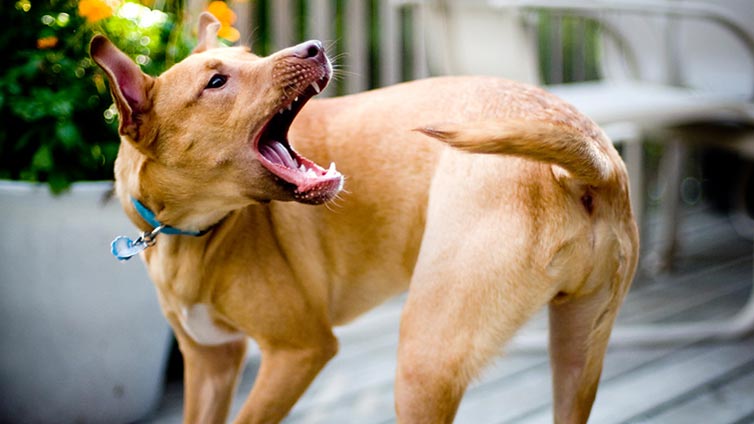Owning a dog brings immense joy, but it also comes with the responsibility of taking care of their health and well-being. If you've noticed your furry companion incessantly biting the base of their tail, it can be concerning and puzzling, especially if you've ruled out fleas as the cause. In this article, we will delve into the reasons why dogs exhibit this behavior, potential underlying health issues, and steps you can take to address and prevent it.

Why is My Dog Biting the Base of Their Tail?
1. Stress and Anxiety
Dogs, like humans, can experience stress and anxiety, which can manifest in various ways, including tail biting. Loud noises, changes in the household, or even unfamiliar environments can trigger stress in dogs. Identifying the sources of stress and providing a safe, stable environment can help alleviate this behavior.
2. Allergies
Allergies are another common cause of tail-biting in dogs. Food allergies or environmental allergens, such as pollen or dust mites, can lead to intense itching and discomfort. Working with your veterinarian to identify and eliminate allergens from your dog's environment is essential.
3. Anal Gland Problems
Anal glands play a crucial role in a dog's scent marking and communication, but they can sometimes become impacted or infected, leading to discomfort and irritation. Dogs may bite their tails as a way to relieve the discomfort caused by anal gland problems.
4. Skin Infections
Skin infections, including bacterial or fungal infections, can cause itchiness and irritation around the tail area. This can lead to repetitive biting and scratching, exacerbating the issue. Proper grooming and topical treatments can help manage and prevent skin infections.
5. Neurological Issues
In some cases, neurological problems or nerve damage can lead to abnormal behaviors in dogs, including tail biting. If your dog's tail-biting behavior is accompanied by other unusual neurological signs, seeking immediate veterinary attention is crucial.

Understanding Stress and Anxiety in Dogs
1. Identifying Stress Triggers
To help your dog overcome stress and anxiety, it's essential to identify the triggers. Everyday stressors include loud noises, separation from their owners, or changes in their daily routine. Once you've identified the triggers, you can work on desensitization techniques.
2. Reducing Stress through Training
Positive reinforcement training methods can help reduce stress and improve your dog's behavior. Rewarding calm and relaxed behavior can reinforce positive associations and help your dog cope with stressful situations better.
3. Providing a Safe Environment
Creating a safe and comfortable environment for your dog is vital for reducing stress. Providing a designated space for your dog to retreat to when feeling overwhelmed can be beneficial. Calming aids, such as pheromone diffusers, can also help create a soothing atmosphere.
Dealing with Allergies

1. Common Allergens for Dogs
Common allergens for dogs include specific proteins in food, pollen, mold spores, and dust mites. Identifying the specific allergen affecting your dog is crucial for managing the allergy effectively.
2. Food Allergies vs. Environmental Allergies
Distinguishing between food allergies and environmental allergies can be challenging, as they may present similar symptoms. Working with your veterinarian to conduct allergy tests can help pinpoint the exact allergen.
3. Working with a Veterinarian to Identify Allergens
A veterinarian can perform allergy testing to identify the root cause of your dog's allergy. Once identified, you can work together to develop a management plan that may include dietary changes or environmental modifications.
Anal Gland Problems and Their Impact
Anal gland problems can be a source of discomfort for dogs and may lead to tail-biting behavior. These small, sac-like glands are located on either side of a dog's anus and play a vital role in communication and scent-marking. When functioning properly, the anal glands release a smelly liquid during bowel movements, helping dogs leave their unique scent.
1. Signs of Anal Gland Issues
When the anal glands don't empty properly, they can become impacted or infected, causing discomfort and irritation for your dog. Some common signs of anal gland issues include:
- Scooting: Your dog may drag their bottom along the ground in an attempt to relieve the discomfort.
- Excessive Licking: Frequent licking of the tail area can be a sign of anal gland problems.
- Foul-Smelling Discharge: You might notice a strong, unpleasant odor around your dog's rear end.
2. Expressing Anal Glands
Expressing the anal glands is a way to alleviate the discomfort caused by impaction or infection. This can be done manually, but it's essential to be cautious as improper handling can lead to further complications. It's best to leave anal gland expression to a professional groomer or your veterinarian, who can do it safely and effectively.
3. Dietary and Lifestyle Adjustments
In some cases, making dietary adjustments can help with anal gland issues. A high-fiber diet can promote regular bowel movements, leading to better natural emptying of the anal glands. Additionally, ensure your dog has enough exercise and stays hydrated, as this can also contribute to a healthy digestive system.
If your dog's anal gland problems persist or become frequent, consult your veterinarian for a proper examination. They can determine the best course of action, whether it's dietary changes, medical treatment, or further investigation to rule out any underlying health concerns. By addressing anal gland issues promptly, you can help your dog find relief and prevent them from resorting to tail-biting as a coping mechanism.
Skin Infections: Causes and Remedies
Skin infections can cause discomfort for dogs and may lead to tail-biting behavior. As a responsible dog owner, it's essential to recognize the signs of skin infections and take appropriate measures to address and prevent them.

1. Recognizing the Signs of Skin Infections
Skin infections can be caused by bacteria, fungi, or parasites, and they often manifest in various ways. Some common signs of skin infections in dogs include:
- Redness and Inflammation: Infected skin may appear red, swollen, and warm to the touch.
- Hair Loss: The infected area may have patches of hair loss or bald spots.
- Excessive Scratching: Dogs with skin infections often scratch or lick the affected area frequently.
- Rashes and Lesions: You might notice raised bumps, sores, or open wounds on your dog's skin.
- Unpleasant Odor: Some skin infections produce a foul smell, indicating the presence of bacteria or yeast.
2. Topical Treatments and Medications
The treatment for skin infections depends on the cause and severity of the infection. In mild cases, topical treatments such as medicated shampoos, ointments, or sprays may be sufficient to alleviate symptoms and promote healing. Your veterinarian can recommend the appropriate topical medication based on the specific infection.
3. Regular Grooming and Hygiene
Proper grooming and hygiene are crucial in preventing and managing skin infections. Regularly bathe your dog with a gentle, hypoallergenic shampoo to keep their skin clean and free from dirt and allergens. However, avoid excessive bathing, as it can strip the skin of its natural oils and worsen certain skin conditions.
4. Addressing Underlying Causes
In some cases, skin infections may be a symptom of an underlying issue, such as allergies or hormonal imbalances. Identifying and addressing these root causes is essential to prevent recurrent infections. Your veterinarian can conduct allergy tests or hormonal evaluations to pinpoint the underlying problem.
5. Preventing Future Infections
To prevent future skin infections, consider the following:
- Regular Vet Checkups: Schedule regular checkups with your veterinarian to catch any potential skin issues early on.
- Proper Nutrition: Feed your dog a well-balanced diet that meets their nutritional needs, as proper nutrition supports a healthy immune system and skin.
- Flea and Tick Prevention: Use appropriate flea and tick prevention measures to protect your dog from parasites that can cause skin problems.
- Environmental Cleanliness: Keep your dog's living area clean and free from potential irritants or allergens.
- Avoiding Harsh Chemicals: Avoid using harsh chemicals or household cleaners that may irritate your dog's skin.
If your dog exhibits signs of a skin infection or if tail-biting persists despite your efforts, consult your veterinarian promptly. They can provide a proper diagnosis and recommend the best course of action to restore your dog's skin health and overall well-being.
Exploring Neurological Issues
1. Nerve Damage and Neuropathic Pain
Nerve damage or neuropathic pain can cause abnormal sensations in your dog's tail, leading to compulsive tail-biting. Seeking prompt veterinary attention is crucial to determine the cause and provide appropriate treatment.
2. Behavioral Changes and Neurological Disorders
Behavioral changes, such as aggression or disorientation, may indicate underlying neurological issues. A comprehensive examination by a veterinarian is necessary to diagnose and manage such conditions.
3. Seeking Professional Diagnosis and Treatment
If you suspect your dog is suffering from a neurological issue, seek veterinary help immediately. Early diagnosis and intervention can significantly improve outcomes.
Preventing Tail Biting
Preventing tail-biting in dogs involves addressing the underlying causes and providing a supportive environment for your furry companion. Tail-biting can be a sign of various issues, including stress, boredom, or health problems. Here are some effective ways to prevent tail-biting behavior and ensure your dog's well-being:
1. Regular Exercise and Mental Stimulation
Engaging your dog in regular physical exercise and mental stimulation is essential for their overall health and happiness. Daily walks, playtime, and interactive toys can help burn off excess energy and reduce stress. Mental stimulation, such as puzzle toys or training exercises, can keep your dog's mind active and prevent boredom-induced behaviors like tail-biting.
2. A Balanced and Nutritious Diet
Proper dog nutrition is fundamental for their well-being. Ensure your dog's diet is balanced and meets their specific nutritional needs. Consult with your veterinarian to determine the best diet for your furry friend, considering factors like age, breed, size, and any underlying health conditions.
3. Ensuring Proper Hygiene and Grooming
Regular grooming and proper hygiene are essential for preventing skin issues that may lead to tail-biting. Brush your dog's coat regularly to remove loose hair and debris. Clean their ears, eyes, and teeth as recommended by your veterinarian. Additionally, keep the anal area clean to prevent anal gland issues.
4. Identifying Stress Triggers
Stress can contribute to tail-biting behavior in dogs. Identify potential stress triggers in your dog's environment and daily routine. Common stressors include loud noises, changes in the household, or unfamiliar visitors. Once you identify these triggers, take steps to minimize their impact and create a safe, calm environment for your dog.
5. Creating a Safe Space
Provide your dog with a designated safe space where they can retreat when feeling overwhelmed. This space can be a cozy corner with their bed or crate, away from noise and commotion. Encourage your dog to use this area whenever they feel anxious or stressed.
6. Behavior Modification Techniques
If your dog has already developed the habit of tail-biting, behavior modification techniques can help redirect their attention. Reward positive behaviors and avoid punishing tail-biting, as punishment can worsen separation anxiety and stress. Instead, use positive reinforcement to encourage alternative behaviors and provide treats or affection when your dog engages in desired actions.
7. Consult Your Veterinarian
If tail-biting persists despite your efforts, or if you suspect an underlying health issue, consult your veterinarian. They can conduct a thorough examination to rule out any medical problems and provide further guidance on managing the behavior.
By taking a proactive approach to your dog's physical and emotional needs, you can create a supportive and enriching environment that reduces the likelihood of tail-biting. Remember to be patient and consistent in your efforts, as behavioral changes may take time. With your love and care, your furry friend can lead a happy, tail-biting-free life.

Addressing the Issue: What You Can Do
1. Consult Your Veterinarian
If your dog's tail-biting behavior persists or worsens, consult your veterinarian for a comprehensive examination. They can help identify any underlying medical conditions and develop a tailored treatment plan.
2. Keep a Journal of Behaviors
Keeping a journal of your dog's behavior patterns can provide valuable insights for your veterinarian. Note any triggers, frequency of tail-biting, and any other relevant information.
3. Implementing Behavior Modification Techniques
Work with a professional dog trainer or behaviorist to implement behavior modification techniques. Positive reinforcement and reward-based training can help redirect your dog's attention away from tail-biting.
Conclusion
Tail-biting in dogs can be a troubling issue, but with patience and the right approach, it is manageable. Understanding the potential causes, whether stress, allergies, anal gland problems, skin infections, or neurological issues, is critical to addressing the problem effectively. By providing a safe and nurturing environment, seeking veterinary advice, and implementing appropriate behavior modification techniques, you can help your furry friend overcome this behavior and lead a happy, healthy life.
FAQs
1. Can stress cause my dog to bite their tail even if they have no other symptoms?
Yes, stress and anxiety can manifest in various ways, and tail-biting is one possible behavior exhibited by stressed dogs, even in the absence of other apparent symptoms.
2. Is tail-biting always a sign of a health problem?
Not necessarily. Tail-biting can be triggered by various factors, including stress, allergies, or boredom. However, if the behavior is persistent or accompanied by other concerning signs, it's essential to consult a veterinarian.
3. Can I express my dog's anal glands at home?
Expressing anal glands should be done cautiously and preferably by a professional groomer or veterinarian to avoid injury or infection.
4. How can I tell if my dog has a skin infection?
Signs of a skin infection include redness, swelling, hair loss, and excessive scratching. If you suspect a skin infection, seek veterinary attention for proper diagnosis and treatment.
5. What if my dog's tail-biting is due to a neurological problem?
If you suspect a neurological issue, seek immediate veterinary attention. A proper diagnosis is essential for developing an appropriate treatment plan to address the problem effectively.




